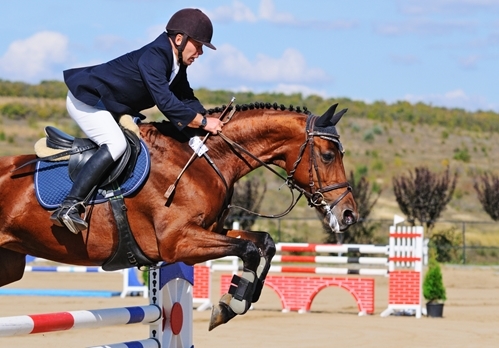While gastric ulcers are one of the more unfortunate health complications horses have to deal with, these painful experiences are relatively common for most adult horses. According to researchers from the University of California, Davis, gastric ulcers occur in anywhere between 50-90 percent of adult horses, generally depending on exercise and training routines. Frequent and demanding physical activity is one of the primary causes of gastric ulcers in hoses, and a new study outlines how showjumping horses are specifically at risk for experiencing high prevalence of gastric ulcers than horses that partake in other activities.Show jumping linked to higher prevalence of gastric ulcers
Researchers from the University of Calgary and TD Equine Veterinary Group collaborated on a study that analyzed how exercise frequency, specifically in showjumping horses, relates to development of gastric ulcers. There were 89 Warmblood showjumping horses from 14 different barns used for the study, and gastroscopies were performed beforehand to test for any preexisting ulcers. The trainers of each horse also completed management surveys, which featured questions ranging from feeding habits, training intensity, competition ability, medication history and more.
After the results were examined, the researchers discovered that ulcer activity was quite common in these highly athletic horses. Out of the 89 Warmblood horses involved in the study, 72 percent of them developed glandular ulcers, with 49 percent of those animals having a grade 2 glandular ulcer or more severe. Glandular ulcers occur within the lower region of the stomach, where hydrochloric acid is produced to aid in digestion. In addition, 40 percent of the horses endured squamous ulcers in the upper region of the stomach, with 28 percent having grade 2 or greater ulcers. Lastly, 34 percent of the horses experienced concurrent ulcers in both the squamous and glandular regions of the stomach.
Risk factors for developing each type of ulcer were also determined by the researchers. Much of the potential of ulcer development had to do with the ratio between feeding frequency as well as exercise schedules. Horses that trained at least six or seven days a week while being provided with hay only once per day were discovered to have the highest risk of contracting grade 2 or high gastric ulcers than any other variables tested in the study. In fact, horses that competed at a national level for showjumping were found to have a higher risk of grade 2 or more severe ulcers than horses participating at the Fédération Equestre Internationale (FEI) level.
Identifying and treating gastric ulcers in horses
Most of the potential signs of ulcers in horses have to do with your horse’s age. In younger foals, general indications of possible ulcer development can range from excessive saliva production, teeth grinding, frequent diarrhea, poor appetite or refusal to eat. In older horses, signs can include noticeable weight loss, decreased muscle tone, poor hair coat, changes in attitude, constantly lying down and overall decrease in performance.
While the amount of exercise your horse is getting is certainly a primary risk factor for potentially developing gastric ulcers, a lot of the danger has to do with appropriately adjusting your animal’s feeding habits in accordance with its training schedule. One of the reasons for this is because the more active your horse is throughout the week, the longer it can take for its stomach to become empty, which can result in large amounts of acid building up within the stomach. According to University of California, Davis researchers, a few dietary tips to consider in regards to protecting your active horse from gastric ulcers can include:
- Appropriately increasing feed intake to stimulate saliva production, which helps buffer stomach acid.
- Decrease the amount of grain and concentrates in your horse’s diet.
- Consider switching to alfalfa hay, which is known to ease digestion and is full of nutrients.
Treating gastric ulcers typically requires specific medications prescribed by your veterinarian, but there are a number of other ways you can aid treatment. Doctors Foster and Smith suggest changes such as increasing the amount of roughage for your horse’s diet, or upping the amount.
_____________________________________________________________________________________
Finish Line’s U7 Gastric Aid is a liquid or powder supplement with botanicals, vitamins and minerals that promotes a healthy digestive system in both the foregut and hindgut.








